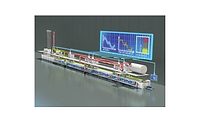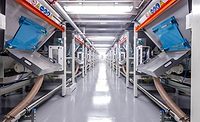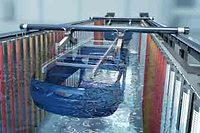Paint Shop for Electric Vehicles in China




The established car manufacturers are increasingly being joined in the market by new competitors, especially in China.
Dürr is currently building a fully automatic paint shop for a local OEM in Hefei in the Anhui Province of China. The plant is designed to handle 100,000 units per year, and will commence operation in June 2018. The integration of numerous digital@DÜRR solutions turns the paint shop into a Smart Factory with extensive use of data.
The new Anhui Jianghuai Automobile (JAC) plant will produce battery-powered cars on behalf of a local electric car manufacturer. The vehicles will be given a modern two-tone color design in the fully automatic Dürr paint shop.
The plant in Hefei combines advanced vehicle drives with intelligent plant technology and modern painting concepts. The entire plant, including data acquisition, data evaluation, and plant monitoring, is controlled by the Dürr software solution iTAC.MES.Suite. The modular MES system provides detailed information on the production workflows and consumption data.
Electric vehicles frequently feature plastic and lightweight components, which are painted separately and not installed in the body until the final assembly line. The workflows in the painting lines are adapting to these changes.
Before the bodies are given their top coat in the painting booth, they undergo pretreatment (PT) and electro-coating (EC). The RoDip rotational dip process is used to apply the corrosion protection coating. The rotational movement of the bodies does away with the need for entry and exit inclines at the tank, saving a considerable amount of space. The smaller tank capacity means that RoDip reduces the costs per unit by using less energy, water, and chemicals.
The seams on the underbody are then sealed, a flat underbody protection is applied, and sound deadening mats are applied to the inside of the body. This is done using the new EcoGun2 3D applicator, which is suitable for all sealing materials and processes. The new channel layout in the applicator head results in a longer service life and a lower pressure level during material feeding. The innovative applicators are mounted on a total of eight EcoRS 16 or EcoRS 30L16 robots, and apply the sealing material automatically to the bodies.
The painting line consists of a primer station as well as one interior and two exterior painting stations for the top coat. Here the bodies are removed in some cases and returned to the top coat line for the two-tone roof painting. The final clear coat is applied in fully automatic interior and exterior painting stations. In order to reduce the solvent emissions as much as possible, the exhaust air flow is purified from the clear coat booths as well as the paint mixing rooms.
Usually the painting process generates large volumes of exhaust air that contains low amounts of contaminants. For this reason, a highly efficient VOC adsorption concentration system (Ecopure® KPR) with a downstream thermal exhaust air control system (Ecopure® TAR) should be installed. The energy required for the Ecopure® KPR system’s desorption air is recovered from the purified gas of the thermal exhaust air purification system which reduces the energy requirement. The highly efficient Dürr Ecopure® exhaust air purification system reduces the solvent emissions by more than 95 percent and ensures that the stringent emission limits are not exceeded.
Fully automatic paint application is handled by a total of 26 EcoRP E/L033 and EcoRP E/L133 painting robots. Eight EcoRP 130 scara robots support the painting process by opening the doors as the EcoRP 133 robot opens the front hood. The trunk lid and fenders are made from plastic on electric vehicles and are not mounted on the body until late in the production process. There is no need for a trunk opener at the rear.
The Hefei paint shop is the first time the EcoBell3 Ci atomizers from Dürr are being used by a local Chinese car manufacturer. They are ideal for painting interiors using water-based paints and require no complex voltage block systems. The compact design enables the atomizers to get into each and every angle inside the body. The robust, high-voltage technology produces minimal inherent soiling and delivers top quality and paint application efficiency. Short rinsing and color change times as well as fast cleaning intervals with the EcoBell Cleaner D2 increase the paint shop’s capacity and productivity.
“Industry 4.0” is the keyword for the digital evolution of traditional production technology into the smart factory of today. With its digital@DÜRR approach, Dürr offers a wide range of solutions. This includes not only the production control iTAC.MES.Suite, but also the integration of a new software solution for fresh and exhaust air control. Dürr’s EcoSmart VEC smart air management system operates automatically, delivering energy on demand. This technology significantly reduces gas and electricity consumption when drying freshly painted bodies. With conventional oven systems heated using purified gas, the fresh air supply system and exhaust air extraction system are operated with a constant volumetric flow rate. Dürr's EcoSmart VEC smart air management system, on the other hand, is a predictive control system. It controls the volumetric flow rate of the fresh and exhaust air depending on the current number of vehicles in the oven and their position.
The system ensures that each individual oven zone is optimally supplied with air at all times, and combines energy efficiency and consistently high paintwork quality. The exhaust air from the ovens is purified via the integrated Ecopure® TAR afterburning system with heat recovery and then made available again for the oven heating system.
The new version of the EcoScreen 3D-OnSite operating software features further smart programming and simulation options. The software coordinates parameterizing, programming, and simulating Ecopaint robots. The new 3D kernel supports all popular CAD data formats.
The EcoRPC robot controller provides smart test functions such as valve, brake or pump tests. They provide a detailed status of the plant technology at any time. The results of the tests are visualized using traffic light functions. This allows the paint operator to easily tell if a valve needs to be replaced immediately or whether everything is working reliably.
Another smart software function of the EcoRPC controls the interaction of the main needle in the atomizer and metering pump. The self-learning system enables high-precision switching points for the robots’ painting paths and at the same time determines the wear to the pump and needle. The sensor-based paint pressure control system ensures minimal mechanical load on the pump, as well as a constant discharge rate and therefore constant process quality.
The robot controllers can be easily incorporated into a centralized data network for the smart factory of the future, and have the capability to transmit all process-related information from the sensors and actuators to higher-level maintenance and control systems at the customer’s site or to the Dürr Service Cloud.
By Dürr
Looking for a reprint of this article?
From high-res PDFs to custom plaques, order your copy today!











